
Pedro Gutiérrez de Valdivia or Valdiva was a Spanish conquistador and the first royal governor of Chile. After serving with the Spanish army in Italy and Flanders, he was sent to South America in 1534, where he served as lieutenant under Francisco Pizarro in Peru, acting as his second in command.

Don Miguel Gregorio Antonio Ignacio Hidalgo y Costilla Gallaga Mandarte y Villaseñor, more commonly known as Miguel Hidalgo y Costilla or Miguel Hidalgo, was a Catholic priest, leader of the Mexican War of Independence and recognized as the Father of the Nation.
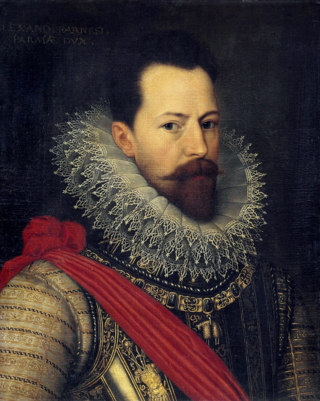
Alexander Farnese was an Italian noble and condottiero, who was Duke of Parma, Piacenza and Castro from 1586 to 1592, as well as Governor of the Spanish Netherlands from 1578 to 1592. As a general of the Spanish army during the Dutch revolt, Farnese captured more than thirty towns in what is now Belgium between 1581 and 1587 and returned them to the control of Habsburg Spain. During the French Wars of Religion he relieved Paris for the Catholic League.

Tariq ibn Ziyad, also known simply as Tarik in English, was an Umayyad commander who initiated the Muslim conquest of Visigothic Hispania in 711–718 AD. He led an army and crossed the Strait of Gibraltar from the North African coast, consolidating his troops at what is today known as the Rock of Gibraltar. The name "Gibraltar" is the Spanish derivation of the Arabic name Jabal Ṭāriq, meaning "mountain of Ṭāriq", which is named after him.

Fernando Álvarez de Toledo y Pimentel, 3rd Duke of Alba, known as the Grand Duke of Alba in Spain and Portugal and as the Iron Duke or shortly 'Alva' in the Netherlands, was a Spanish noble, general and diplomat. Alba achieved notoriety for his actions during the Eighty Years' War in the Spanish Netherlands, where his prolonged military campaigns and harsh repression failed to suppress the Dutch Revolt.
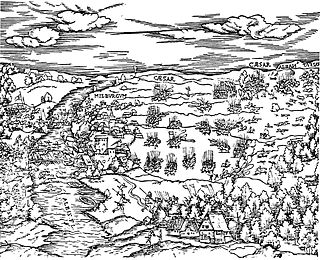
The Battle of Mühlberg took place near Mühlberg in the Electorate of Saxony in 1547, during the Schmalkaldic War. The Catholic princes of the Holy Roman Empire led by the Holy Roman Emperor Charles V decisively defeated the Lutheran Schmalkaldic League of Protestant princes under the command of Elector John Frederick I of Saxony and Landgrave Philip I of Hesse.

The national flag of Spain, as it is defined in the Constitution of 1978, consists of three horizontal stripes: red, yellow and red, the yellow stripe being twice the height of each red stripe. Traditionally, the middle stripe was defined by the more archaic term of gualda, and hence the popular name la Rojigualda (red-weld).
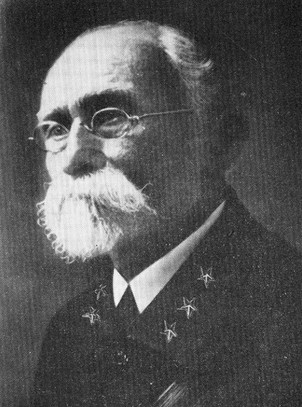
Máximo Gómez y Báez was a Cuban-Dominican Generalissimo in Cuba's War of Independence (1895–1898). He was known for his controversial scorched-earth policy, which entailed dynamiting passenger trains and torching the Spanish loyalists' property and sugar plantations—including many owned by Americans. He greatly increased the efficacy of the attacks by torturing and killing not only Spanish soldiers, but also Spanish sympathizers and especially Cubans loyal to Spain. By the time the Spanish–American War broke out in April 1898, the rebellion was virtually defeated in most of Western Cuba, with only a few operating pockets in the center and the east. He refused to join forces with the Spanish in fighting off the United States, and he retired to the Quinta de los Molinos, a luxury villa outside of Havana after the war's end formerly used by captains generals as summer residence.
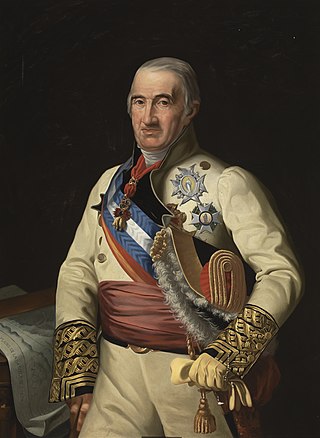
Francisco Javier Castaños Aragorri, 1st Duke of Bailén was a Spanish Army officer, politician and nobleman who served during the French Revolutionary and Napoleonic Wars. He presided over the Regency Council of Spain and the Indies, in 1810. From July to September 1834, Castaños served as the first president of the Senate of Spain, at that time called the House of Peers.
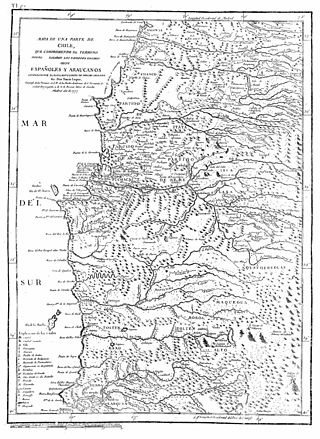
The Arauco War was a long-running conflict between colonial Spaniards and the Mapuche people, mostly fought in the Araucanía region of Chile. The conflict began at first as a reaction to the Spanish conquerors attempting to establish cities and force Mapuches into servitude. It subsequently evolved over time into phases comprising drawn-out sieges, slave-hunting expeditions, pillaging raids, punitive expeditions, and renewed Spanish attempts to secure lost territories. Abduction of women and war rape was common on both sides.

The Battle of Gembloux took place at Gembloux, near Namur, Low Countries, between the Spanish forces led by Don John of Austria, Governor-General of the Spanish Netherlands, and a rebel army composed of Dutch, Flemish, English, Scottish, German, French, and Walloon soldiers under Antoine de Goignies, during the Eighty Years' War.
Francisco López de Zúñiga y Meneses, 2nd Marquess of Baides and Count of Pedrosa was a Spanish soldier who served as Royal Governor of Chile from May 1639 to May 1646.

The Battle of Montes Claros was fought on 17 June 1665, near Borba, between Spanish and a combined Anglo-Portuguese force as the last major battle in the Portuguese Restoration War. The battle resulted in a decisive Portuguese victory and is considered one of the most important battles in the country's history.
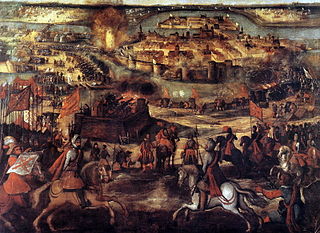
The siege of Maastricht was a battle of the Eighty Years' War which lasted from March 12 to July 1, 1579. The Spanish were victorious.
Óscar Omar Treviño Morales is a Mexican convicted drug lord and former leader of Los Zetas, a criminal organization. He was one of Mexico's most-wanted drug lords. His brother is Miguel Treviño Morales, a former leader of the group. The authorities believe he was the successor of his brother, who was arrested on July 15, 2013.

The siege of Castelnuovo was an engagement during the Ottoman-Habsburg struggle for control of the Mediterranean, which took place in July 1539 at the walled town of Castelnuovo, present-day Herceg Novi, Montenegro. Castelnuovo had been conquered by elements of various Spanish tercios the year before during the failed campaign of the Holy League against the Ottoman Empire in Eastern Mediterranean waters. The walled town was besieged by land and sea by a powerful Ottoman army under Hayreddin Barbarossa, who offered an honourable surrender to the defenders. These terms were rejected by the Spanish commanding officer Francisco de Sarmiento and his captains even though they knew that the Holy League's fleet, defeated at the Battle of Preveza, could not relieve them. During the siege, Barbarossa's army suffered heavy losses due to the stubborn resistance of Sarmiento's men. Even the Venetian refused the promised naval link to Castelnuovo with the supplies and reinforcements; after a general troop parliament, the commanding officer Francisco de Sarmiento asked his captains what his answer should be to Barbarossa's offer to surrender. The captains responded: "Que vengan cuando quieran". However, Castelnuovo eventually fell into Ottoman hands and almost all the Spanish defenders, including Sarmiento, were killed. The loss of the town ended the Christian attempt to regain control of the Eastern Mediterranean. The courage displayed by the Old Tercio of Naples during this last stand, however, was praised and admired throughout Europe and was the subject of numerous poems and songs.
The Battle of Landriano took place on 21 June 1529, between the French army under Francis de Bourbon, Comte de St. Pol and the Imperial–Spanish army commanded by Don Antonio de Leyva, Duke of Terranova in the context of the War of the League of Cognac. The French army was destroyed and the battle's strategic result was that the struggle between Francis I of France and Charles V, Holy Roman Emperor for control of northern Italy was temporarily at an end.

The Battle of Tenancingo was a military action of the Mexican War of Independence fought on 22 January 1812 on the outskirts of Tenancingo de Degollado, Mexico. The battle was fought between the royalist forces loyal to the Spanish crown and the Mexican rebels fighting for independence from the Spanish Empire. The Mexican insurgents were commanded by General José María Morelos y Pavón and the Spanish by Rosendo Porlier y Asteguieta. The battle resulted in a victory for the Mexican rebels.

José Moldes was an Argentine military leader. He was born in the Salta Province, and moved to Spain in his infancy. His father was Antonio Moldes y González, from Barro. He served in the Spanish army, and joined lodges in Cádiz opposed to the absolutist monarchy. He left Spain and moved to Buenos Aires, supporting the faction of Mariano Moreno after the May Revolution. He was exiled by the 1811 coup, but returned to the Assembly of the Year XIII. He was proposed in 1816 as a possible Supreme Director of the United Provinces of the Río de la Plata by deputies of the Congress of Tucumán, but José de San Martín feared that his strong feud with Buenos Aires may break national unity, and opposed his candidacy.

Ramón Castilla, also known as Field Marshal Ramón Castilla or Ramón Castilla y Marquesado, is an outdoor bronze sculpture of the Peruvian caudillo and President of the same name by an unknown artist, installed at Hermann Park's McGovern Centennial Gardens in Houston, Texas, in the United States. The bust had been installed in Hermann Park's International Sculpture Garden since 1991.
















